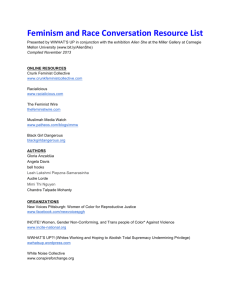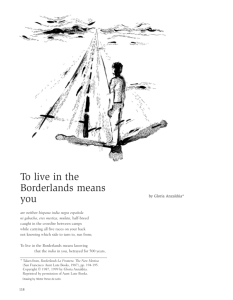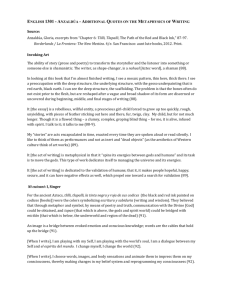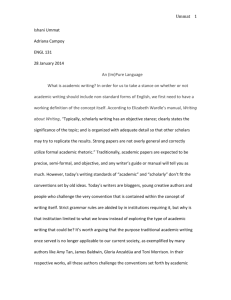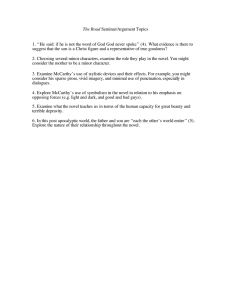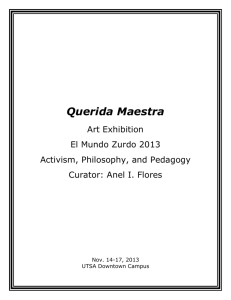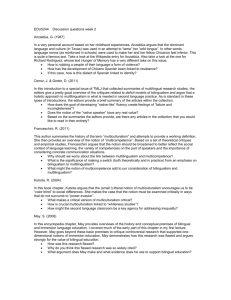1 Signs Since at least the 1970s, Latin@ and Chican@ cultural productions...
advertisement
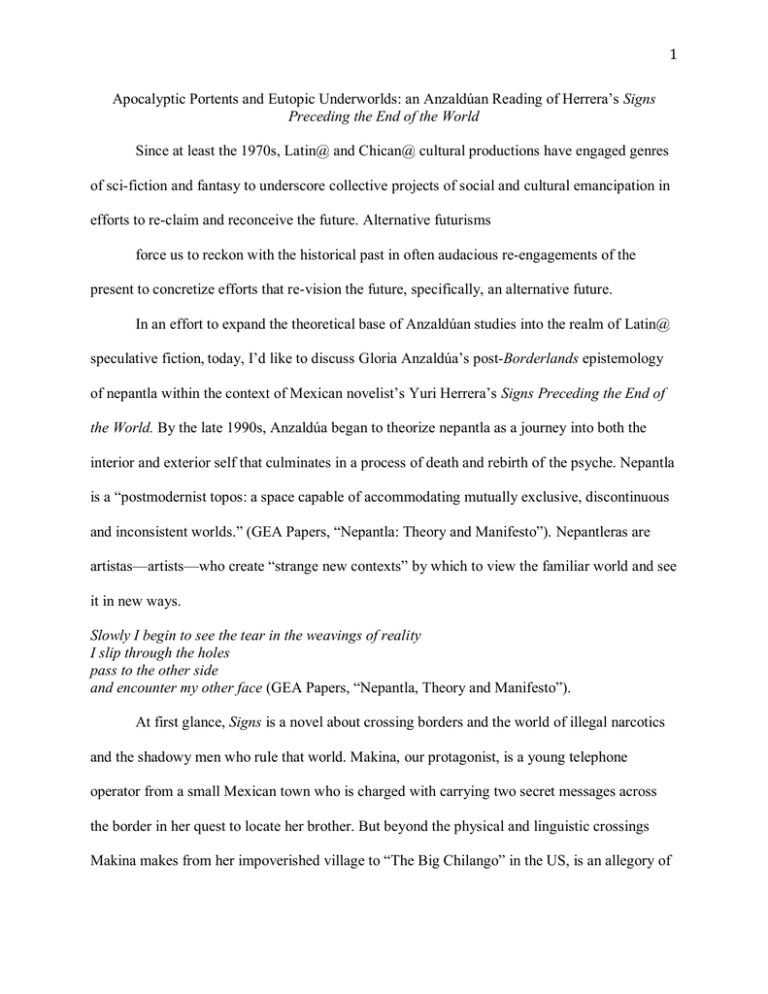
1 Apocalyptic Portents and Eutopic Underworlds: an Anzaldúan Reading of Herrera’s Signs Preceding the End of the World Since at least the 1970s, Latin@ and Chican@ cultural productions have engaged genres of sci-fiction and fantasy to underscore collective projects of social and cultural emancipation in efforts to re-claim and reconceive the future. Alternative futurisms force us to reckon with the historical past in often audacious re-engagements of the present to concretize efforts that re-vision the future, specifically, an alternative future. In an effort to expand the theoretical base of Anzaldúan studies into the realm of Latin@ speculative fiction, today, I’d like to discuss Gloria Anzaldúa’s post-Borderlands epistemology of nepantla within the context of Mexican novelist’s Yuri Herrera’s Signs Preceding the End of the World. By the late 1990s, Anzaldúa began to theorize nepantla as a journey into both the interior and exterior self that culminates in a process of death and rebirth of the psyche. Nepantla is a “postmodernist topos: a space capable of accommodating mutually exclusive, discontinuous and inconsistent worlds.” (GEA Papers, “Nepantla: Theory and Manifesto”). Nepantleras are artistas—artists—who create “strange new contexts” by which to view the familiar world and see it in new ways. Slowly I begin to see the tear in the weavings of reality I slip through the holes pass to the other side and encounter my other face (GEA Papers, “Nepantla, Theory and Manifesto”). At first glance, Signs is a novel about crossing borders and the world of illegal narcotics and the shadowy men who rule that world. Makina, our protagonist, is a young telephone operator from a small Mexican town who is charged with carrying two secret messages across the border in her quest to locate her brother. But beyond the physical and linguistic crossings Makina makes from her impoverished village to “The Big Chilango” in the US, is an allegory of 2 apocalyptic hope and transformation. In the novel, Makina, is a nepantlera who is positioned to facilitate a passage between worlds (Reader 322) in an effort to heal the body/spirit split that, for Anzaldúa, lies at the center of the “despot duality” (41 Borderlands) that continues to enslave citizens, whether mestizos or otherwise. But before I dive into this strange, sparse novel of a hopeful apocalypse, Id’ like to situate both the novel and Anzaldúa’s theory of nepantla within a broader discourse of speculative fiction so as to engage ideas central to utopian social dreaming and apocalyptic hope. This is actually what my larger project is about—Utopian/Apocalyptic dreaming on the Borderlands. Darko Suvin’s definition of science fiction as a literary genre predicated on the presence and interaction of estrangement within an imaginative framework alternative to the author’s empirical environment (6-7) is helpful in positioning Herrera’s novel as one that both estranges and incorporates alternative landscapes. Suvin’s definition remains a standard in the literature…most likely because it pushes us to evaluate tropes of defamiliarization, a postmodern literary technique that both estranges and enhances perceptions of the familiar. As we will see, although Signs appears to take place in the present or a mimetically parallel future present, the first and final chapters of the novel interweave mythic time into the cosmic time of the novel. And it’s this interweaving of worlds that I’d like to discuss today. Signs Preceding the End of the World begins with a sinkhole, a “perfect circle” that periodically swallows a few citizens of his unnamed Mexican city. Makina, our heroine, narrowly escapes being devoured by the sinkhole, yet it is not her last encounter with this collapse of terrain beneath her body. By the novel’s end, she will find her way first through a “maze of streets that look[ed] like they belong[ed] to some other city” and through a door where she descends to a subterranean place that is “a song from long ago.” What’s most astonishing 3 about this space, I argue, is the water imagery that accompanies Makina’s transformation. It’s water that feeds the otherworldly, utopic pulse of this book. In the novel, the Underworld is the dominion of a primal cenote, a heterotopic space of indigenous knowledge and eutopic terrain of apocalyptic hope. The novel’s sinkhole motif serves as a nucleus of estrangement for a reader and establishes a link to Anzaldúa’s eutopic impulses regarding the power of el cenote. The final chapter of Herrera’s novel evokes Anzaldúa’s “sueño con serpientes” section of Borderlands. In this chapter, Anzaldúa enters the serpent’s belly in an attempt to coalesce the lost pieces of herself—fragments of both flesh and spirit rent asunder by institutionalized religion, white rationality (59, 58 Borderlands) and a Culture that keeps women and indeed all transgressors in rigidly defined roles. Similarly, in the final chapter of Signs, Makina is “skinned” in a subterranean world, where there is nothing but, “the sound of running water” and “the energetic coursing of subterranean rivers” (106). Underground, in a swirl of cyclical time, Makina drops the “weight of uncertainty and guilt” (107) as the pitfalls of chronological time collapse to suggest a “return odyssey” in which she may reclaim the lost aspects of her indigenous identity. Her personal transformation is an invitation that reminds us that “there are realities and other truths beyond dominant realities that privilege the few, [and] [that] we must be willing to make painful spiritual crossings through Coatlicue states to discover them” (Susana Ramírez 213). I mentioned the word cenote a while ago, and I want to talk a little bit about this now. Spiritual activism, for Anzaldúa is a twofold journey that begins by unearthing deep and unexplored hidden knowledges within the self and expands outward into the world: I have a topoi, a place I call el cenote. In my imagination, I descend into this dreampool, sinkhole, deep well. I access my culture’s collective history as well as my own personal 4 reservoir of memories. Memories collide, conflict, converge, condense and negotiate relationships between past, present and future. I piece together fragments of these imagined collective memories, using figures, myths, and stories such as Cihuatyotl (La Llorona), Coatlique, and Coyolxauhqui to re-enact and re-write specific psychological realities of Chicanas/Latinas in our world (GEA Papers, “Nepantla: Theory and Manifesto”). The cenote world is haunted by and brimming in uncanny signs. The mestiza, whose body is a “geography of selves,” stands at the threshold of a voluminous world to negotiate the liminal spaces and cracks between them; she strives—hungers—to decipher their meanings, decode a secret language “that speaks of what is other.” (GEA Papers, “Nepantla: Theories of Composition”). By “listening to the environment and our inner cenotes” proclaims Anzaldúa, we can begin the work of progressing beyond the veils and distortions wrought by traditional, often debilitating hierarchical ways of experiencing the world. When we train ourselves to listen to our environment and our “inner cenotes,” the closeted dreampools of our inner selves—those marked in the red and black ink of ancient metaphors and primal memories—we cultivate an empathy with the world, an openness to other dimensions and realities of existence often divorced from the familiar and everyday. (GEA Papers, “Nepantla: Theory and Manifesto”) Cenotes are primordial sites deeply ingrained in the belief systems of the ancient Maya. Anzaldúa incorporates and explores ancient Aztec and Maya images in her writing. For Chicanas, she reasons, appropriating indigenous Mexican symbols and myths in a historical and contemporary context is a “mechanism of resistance to oppression and assimilation” (164). Only when and if we actively look beyond the tangible will we discover connections to the underworld, the spirit world—other realities. This becomes necessary to mete out 5 institutionalized historical and cultural oppression that has, for generations, aimed to placate Indians, mexicanos, and Chicanos. To gain what has been lost requires a digging up of metaphoric and symbolic roots as well as an overturning of dominant, bifurcating, Western practices. The Chichen Itza cenote in the Yucatan Peninsula is an archaic site whose surface the ancient Maya believed was a a giant mirror for divination and augury. In the early 20th century archaeologists dredged the cenote and uncovered offerings made of jade, pottery, and gold disks, and human skeletal remains that show marks of ritual sacrifice. According to the scholarship, the bottom of the sacred cenote was at least one entry point to the Underworld. In the Popol Vuh, the most important surviving book of the Quiché Maya, souls traveled to the Underworld and faced numerous hazards such as obsidian blades, arrow sacrifices, and dangerous waters (Makina, by the way, tackles such hazards in Signs). Miller and Taube (Gods and Symbols of Ancient Maya) write that “Some gods were known to travel in and out of the Underworld: to create a new generation of mankind” (178). They illustrate this idea with the story of Quetzalcoatl, who descended into the Underworld to steal the bones of an earlier race of humans. The Mayan Underworld, according to some, is comprised of eight layers. In Signs, Makina traverses 8 hills before she catches sight of her brother in “The Big Chilango.” Because she legitimates the experiential and the ontological with regard to her postmodern idea of el cenote, Anzaldúa nurtures a dialogue at the heart of the crisis in the production and ultimate dissemination of knowledge. In an interview with AnaLouise Keating, a preeminent Anzaldúa scholar working today, Anzaldúa discusses why the “spiritual” aspects of her writing have often been ignored. The “safe” elements—the theoretical, the historical, the borderlands imagery—are appropriated and studied, she says. The “unsafe” elements are 6 ignored. “One of the things that doesn’t get talked about is anything that has to do with the sacred…the spirit…When I start talking about nepantla—as a border between the spirit, the psyche, and the mind as a process—they resist” (1993 interview w Keating in Interviews/Entrivistas 7 “Risking the Personal”). To be clear, it’s not a Christian spirituality that Anzaldúa articulates throughout her writings, but a spirituality that concerns multiple nodes that fuse contemplation and private rituals with the technologies of political activism (Susana Ramírez 211). In Signs, Makina both literally and figuratively descends into the body of the earth. Led by Chucho, the enigmatic coyote figure who first accompanied her on her watery crossing from her little village to “The Big Chilango,” in the Underworld, Makina is greeted first by an old woman with “long white fingernails and a powdered face” who wears a butterfly pin. Spiraling downward and descending like a sleepwalker, she is received by a thin man with yellow teeth, a figure reminiscent of the Bacab, or the sky-bearer who guards the entrance of the Chichen cenote. Here, under the earth, as time ceases, and Makina finally understands “with all of her body and all of her memory” (107) that her story, and, consequently, the story that enfolds us all is “not a cataclysm” (107) but a revelation, a cosmic unveiling that accompanies her physical and spiritual transformation. In this eerie novel, full of water imagery and landscapes that “promise other things, signify other things, produce different objects” (66) Makina is a nepantlera whose journey culminates in a re-conceptualized future. Her crossing of worlds is figurative and literal and signifies a transformation of the interior and exterior self, and it culminates in a process of death and rebirth of the psyche as well as the body. The lifeblood that courses through Signs is primal, apocalyptic, and above all, utopic. It is both a “non-place” and a “good” place, combining both etymological forms of the term, which 7 was coined by Sir Thomas More in 1516. The apocalyptic in Signs is palpable and defamiliarizing. But the operative word here is “order.” Elizabeth K. Rosen, in Apocalypse and the Postmodern Imagination makes the case for the apocalyptic impulse in modern literary productions, much as Frederic Jameson makes the case for a utopian impulse. Apocalyptic impulses help us make sense of dislocating historical events (xii), generally engage moral dimensions, and smack of original myth. What more dislocating historical event can we imagine than the otherworldly chaos engendered by the so-called “War on Drugs” along the US-Mexico border? By the same token, the utopic impulse in Signs appears in direct parallel to the impulses we find at work throughout Anzaldúa’s canon. Frederic Jameson in The Desire Called Utopia differentiates between utopian forms and utopian impulses. Early literary utopias, such as Plato’s Republic, More’s Utopia, and even Gilman’s feminist utopia Herland (1915), tend to be ahistorical societies where there is no progress after the ideal civilization has been established. These utopias are blueprints, or templates. A utopian impulse, however, serves as a “lure and bait for ideology” (Archaeologies 3) that is, in general, an allegorical outline for a better world. When we recall that the sacred Chichen cenote was an integral pilgrimage destination that likely served as the foci of worship dedicated to the chacs, or rain gods, we are forced to reckon with originary arbiters of meaning that have been effectively pushed into the unconscious. Because, argues Anzaldúa “metaphors are gods” (164), in recovering the old metaphors—the old gods—we nourish them, as do both Anzaldúa and Herrera. It is this reconfiguration of the sacred, at once imagined and invoked, that effectively frames the diverse nodes and theorizing processes that signify the utopic and apocalyptic hope in Signs. The sinkhole in Signs is more than a breach in the earth, it is a portal that exposes a rupture in time and space. Like a wormhole that we might find in a classic sci-fi text, the 8 sinkhole opens up another world, a world of cenotes and a lost Mayan Underworld, a world that Anzaldúa envisioned—from as early as Borderlands/La Mestiza, to later theories about nepantleras that she was working through just before her death in 1994—could broaden the work of social justice. Anzaldúa’s nepantla state is the terrain of “those who…struggle for social justice, who want to cultivate visions of a better, more just world.” It is a continually shifting zone of transition that signifies “the point of contact between the world of nature and the world of spirit, between humans and the numinous and the joining of these worlds through ritual transformation.” In this extreme state of being, one balances the worldview of contemporary society alongside non-ordinary worldviews. For Anzaldúa, it is the act of butting up against separate, often disparate realities that pushes one—through acts of creative will—to see clearly. But we must be willing to look beyond singular paths of knowing, in ways that engage multiple, even dissonant, nodes of perception. This involves the risk of being swallowed whole by the earth’s mouth as Anzaldúa describes in “The Coatlicue State”. It is only when we break holes in the old boundaries that we, unwrest “that which abides” to become a thousand sleepless serpent eyes. (Borderlands 1999). It is only then that we awaken.
